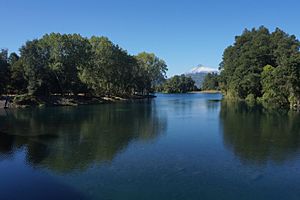Pullinque Lake facts for kids
Quick facts for kids Pullinque LakeLago Pullinque |
|
|---|---|

Pullinque Lake and Villarrica Volcano as seen at Bocatoma Bridge, Región de los Ríos, Chile
|
|
| Location | Panguipulli |
| Coordinates | 39°33′54″S 72°08′53″W / 39.5650°S 72.1481°W |
| Type | Glacial |
| Primary inflows | Pullinque River |
| Primary outflows | Guanehue River |
| Basin countries | Chile |
The Pullinque Lake (which is Lago Pullinque in Spanish) is a beautiful body of water in southern Chile. It is one of the famous "Seven Lakes" found in the Panguipulli area. This lake was formed by ancient glaciers. It sits between two other well-known lakes, Calafquén and Panguipulli Lake. Near its southwestern edge, where water flows out, you can find the Pullinque Hydroelectric Plant.
Contents
About Pullinque Lake
Pullinque Lake is a natural wonder in the Los Ríos Region of Chile. It is known for its clear waters and the stunning natural scenery around it. The lake is an important part of the local environment and economy.
Where is Pullinque Lake?
Pullinque Lake is located in the southern part of Chile. It is part of a group of lakes known as the "Seven Lakes." These lakes are all connected and are found in the Panguipulli municipality. This area is famous for its beautiful landscapes, including volcanoes and forests. The lake's position makes it a key part of the region's water system.
How Pullinque Lake Formed
Pullinque Lake is a type of lake called a glacial lake. This means it was created a very long time ago by huge sheets of ice, called glaciers. As these glaciers moved across the land, they carved out deep valleys and basins. When the glaciers melted, these basins filled with water, forming lakes like Pullinque. This process left behind a unique shape and depth for the lake.
Power from the Lake
An important feature near Pullinque Lake is the Pullinque Hydroelectric Plant. This plant uses the water flowing out of the lake to create electricity. Hydroelectric plants are a way to generate clean energy. They use the power of moving water to spin turbines, which then produce electricity. This plant helps provide power to homes and businesses in the region. It shows how natural resources can be used to benefit people.
See also
 In Spanish: Lago Pullinque para niños
In Spanish: Lago Pullinque para niños


